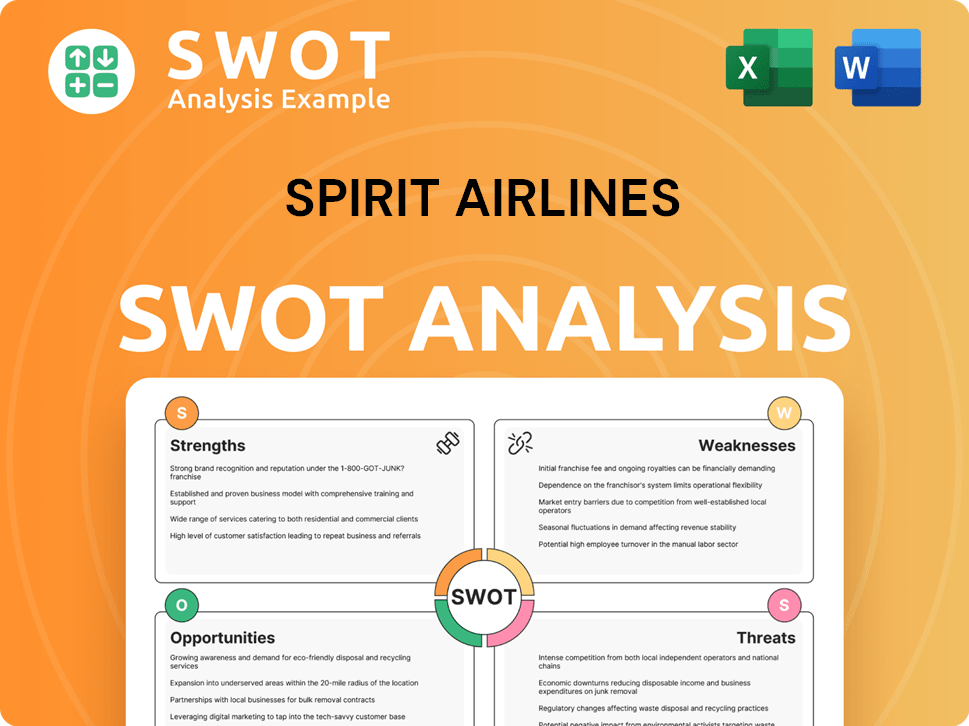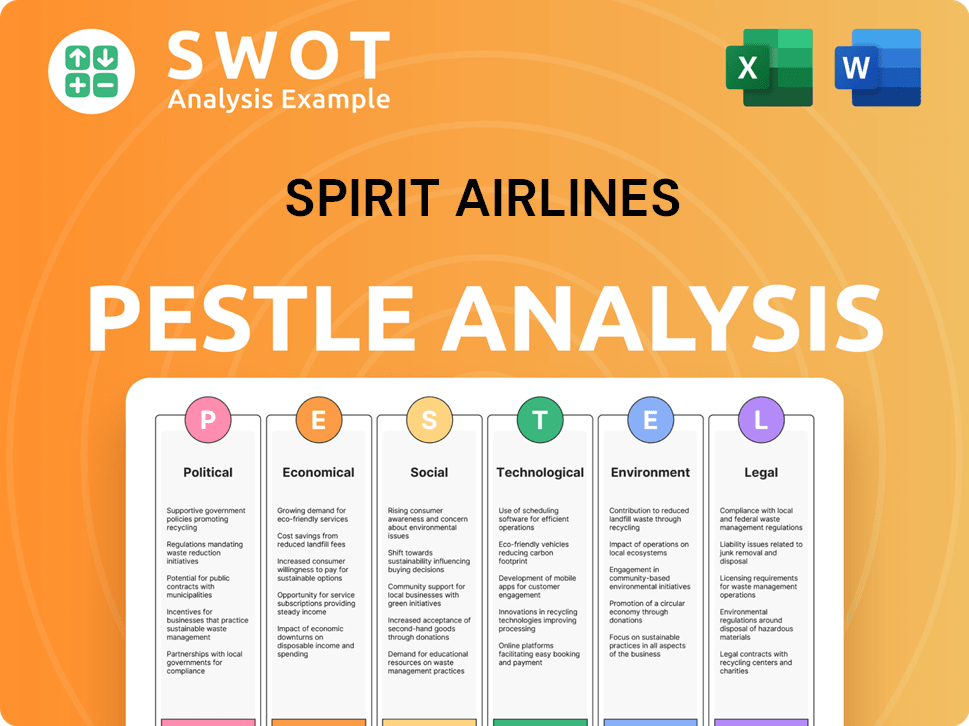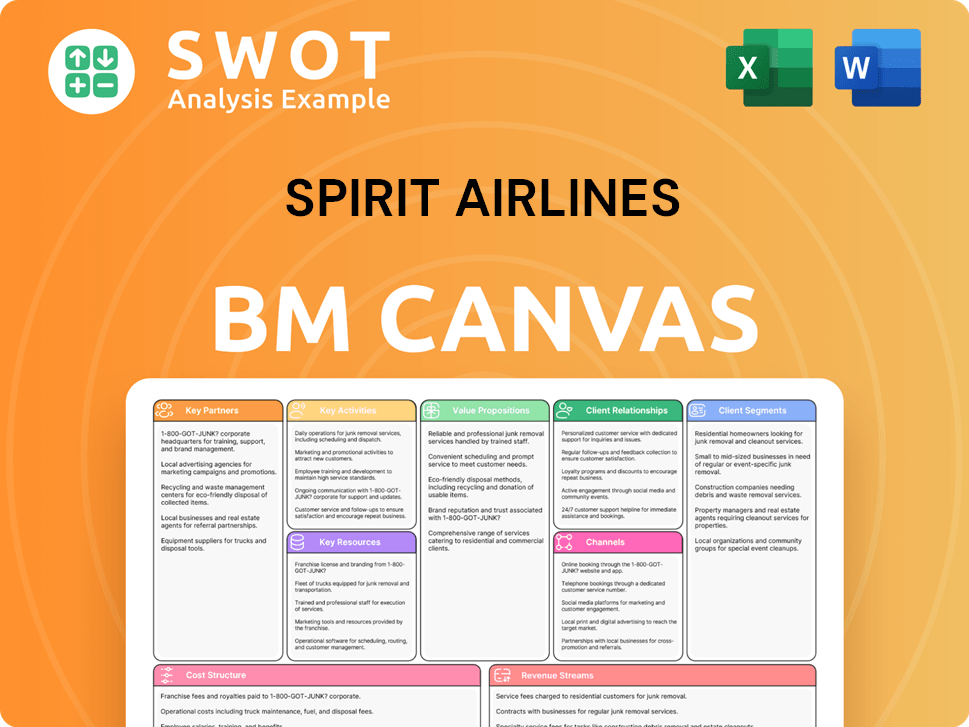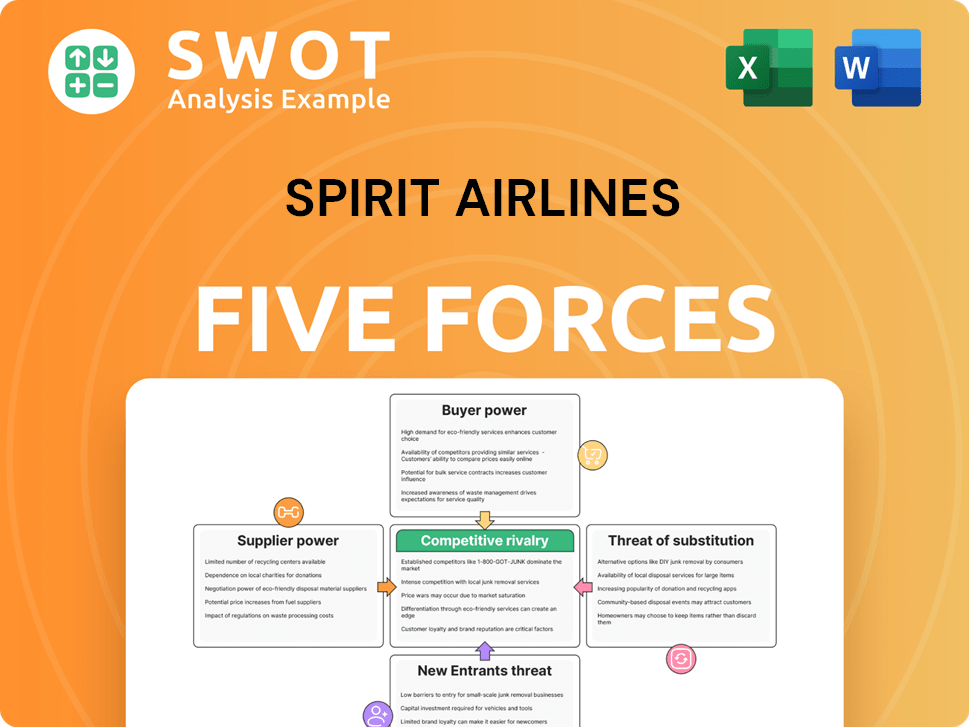Spirit Airlines Bundle
What Drives Spirit Airlines' Flight Path?
Understanding a company's mission, vision, and core values is crucial for investors and strategists alike. These foundational elements shape a company's identity and guide its actions, especially in the competitive airline industry. Delve into the heart of Spirit Airlines to uncover its guiding principles.

Spirit Airlines, a prominent ultra-low-cost carrier, relies heavily on its Spirit Airlines SWOT Analysis to navigate the industry landscape. Examining its mission, vision, and core values provides critical insights into its strategic plan and vision for the future. This analysis reveals how Spirit Airlines defines its mission and aligns its company culture with its long-term goals.
Key Takeaways
- Spirit Airlines focuses on affordable travel for budget-conscious travelers.
- The ultra-low-cost model is central to Spirit's strategy, supported by a young fleet.
- Recent financial struggles, including a $1.2B loss in 2024, necessitate strategic realignment.
- Balancing affordability with improved service and reliability is key for future success.
- Adapting to market changes while maintaining a clear purpose is crucial for Spirit's survival.
Mission: What is Spirit Airlines Mission Statement?
Spirit Airlines' mission is to deliver the best value in the sky, providing customizable travel options through an unbundled fare structure.
Let's delve deeper into the Owners & Shareholders of Spirit Airlines mission.
The Spirit Airlines Mission statement is centered around value. It aims to make air travel accessible by offering low base fares. This is achieved through an unbundled fare model, allowing customers to pay only for the services they need.
The mission is inherently customer-centric. It focuses on providing affordable choices. The "La Smarte" approach, where passengers customize their experience, is a direct reflection of this focus.
Spirit's mission is supported by operational efficiency. Their young, fuel-efficient fleet, known as the "Fit Fleet®," helps keep costs down. This supports their ability to offer competitive fares.
The mission statement also touches upon their geographic scope. Spirit Airlines operates across the U.S., Latin America, and the Caribbean. This indicates their ambition for growth and expansion.
The mission statement guides Spirit's strategic decisions. This includes route planning, fleet management, and marketing efforts. It helps define their competitive advantage in the airline industry.
Spirit Airlines' mission directly informs its goals. These include increasing market share, improving operational efficiency, and enhancing customer satisfaction. The goal is to maintain its position as a low-cost carrier.
The mission statement is a cornerstone of Spirit Airlines' identity. It shapes their business model and guides their operations. As of late 2024, Spirit Airlines operated approximately 600 daily flights to 73 destinations, showcasing the mission in action. The commitment to a young fleet, with an average aircraft age of around 5.5 years, is another key element supporting the mission's focus on value and efficiency. This commitment to fuel efficiency is particularly important in an environment where fuel costs represent a significant portion of operating expenses, with fuel costs accounting for roughly 30% of total operating expenses in the airline industry.
Spirit Airlines SWOT Analysis
- Complete SWOT Breakdown
- Fully Customizable
- Editable in Excel & Word
- Professional Formatting
- Investor-Ready Format

Vision: What is Spirit Airlines Vision Statement?
Spirit Airlines' vision is 'to be the airline of choice for budget-conscious travelers, offering a comfortable and convenient travel experience.'
Let's delve into the vision of Spirit Airlines. The Competitors Landscape of Spirit Airlines reveals a dynamic market, and understanding Spirit's vision is crucial for assessing its future prospects. This vision statement, as of April 2025, is forward-looking, focusing on becoming the preferred airline for budget travelers. It extends beyond mere affordability, aiming to provide a travel experience that is both comfortable and convenient.
The vision is aspirational, setting a high standard for customer experience within the budget airline sector. It implies a commitment to continuous improvement and a focus on exceeding customer expectations.
The vision implicitly seeks market leadership within the budget travel segment. It aims to be the go-to airline for travelers prioritizing cost-effectiveness without sacrificing comfort and convenience.
Spirit Airlines' financial health is a critical factor in realizing its vision. The company emerged from Chapter 11 bankruptcy in March 2025 after reporting a net loss of $1.2 billion in 2024. This financial restructuring is crucial to supporting future initiatives.
Recent strategic adjustments, including new fare options and a focus on enhancing the customer experience, suggest a commitment to the "comfortable and convenient" aspect of their vision. These are vital for achieving their Spirit Airlines Goals.
Spirit Airlines was named the Best Airline Overall for 2025 by WalletHub based on 2024 data, which considered safety and affordability. This recognition indicates progress toward the vision.
The Spirit Airlines Strategy must align with this vision. The vision statement guides the company's strategic decisions, from route planning to customer service improvements, ensuring all efforts contribute to the desired outcome.
The core of Spirit Airlines Vision is to be the preferred choice for budget travelers. The company's ability to achieve this vision hinges on its financial stability, strategic execution, and commitment to its Spirit Airlines Core Values. While the path ahead presents challenges, the vision provides a clear direction for the future. Understanding Spirit Airlines Mission and how it interacts with its vision is essential for a complete picture of the airline's strategic direction. The Spirit Airlines Company Culture will also play a significant role in realizing this vision. The long-term success of Spirit Airlines will depend on its ability to consistently deliver on its promise of affordable, comfortable, and convenient travel, solidifying its position in a competitive market. The Spirit Airlines' long-term goals and objectives are directly influenced by this vision.
Spirit Airlines PESTLE Analysis
- Covers All 6 PESTLE Categories
- No Research Needed – Save Hours of Work
- Built by Experts, Trusted by Consultants
- Instant Download, Ready to Use
- 100% Editable, Fully Customizable

Values: What is Spirit Airlines Core Values Statement?
Understanding the core values of Spirit Airlines provides insight into the airline's operational philosophy and its approach to business. While not explicitly stated in a numbered list, Spirit Airlines' commitment to key principles shapes its corporate identity and guides its actions.
Safety is a paramount concern for Spirit Airlines, reflecting its adherence to stringent industry regulations. Their young fleet, recognized as one of the youngest in the U.S. and one of the most fuel-efficient in 2025, contributes to a strong safety profile. Spirit's commitment is further demonstrated by receiving the FAA Diamond Award of Excellence for seven consecutive years, underscoring their dedication to maintenance and safety standards.
Delivering 'the best value in the sky' is a central tenet of Spirit Airlines' mission and a key driver of its strategy. This value is embodied in their unbundled fare model, which allows customers to customize their travel and pay only for the services they need. This approach has helped Spirit Airlines attract budget-conscious travelers and differentiate itself in the competitive airline market.
Spirit Airlines is increasingly focused on enhancing the 'Guest experience,' reflecting a growing emphasis on customer satisfaction. Initiatives like the introduction of new fare bundles in 2024, offering varying levels of service and amenities, showcase this evolving value. This shift aims to improve customer loyalty and position Spirit as a more customer-centric airline, building on its Brief History of Spirit Airlines.
Spirit Airlines demonstrates a commitment to community engagement through the Spirit Charitable Foundation. The foundation supports various initiatives focused on children and families, service members, and the environment. This value is manifested through partnerships with non-profit organizations and programs like flying veterans to Washington, D.C., reflecting a broader commitment to social responsibility.
These core values—Safety, Value, Guest Experience, and Community Engagement—collectively define Spirit Airlines' company culture, emphasizing affordability, operational excellence, and a growing focus on customer satisfaction and social responsibility. Understanding these values is crucial for comprehending the airline's strategic direction and its long-term goals. The next chapter will explore how the Spirit Airlines Mission and Vision influence the company's strategic decisions.
How Mission & Vision Influence Spirit Airlines Business?
Spirit Airlines' mission and vision are fundamental to its strategic direction, shaping its business model and influencing key operational decisions. Understanding these guiding principles is crucial to grasping Spirit's approach to the competitive airline industry.
Spirit Airlines' mission, "to deliver the best value in the sky," and its vision, "to be the airline of choice for budget-conscious travelers," directly influence its strategic decisions. This includes pricing, route selection, and fleet management. These core values are the foundation of their strategic initiatives.
- Unbundled Fare Structure: This is a direct implementation of their mission to provide customizable, low-cost travel. It influences everything from their booking process to their in-flight service, where customers pay for extras. While this model has faced criticism for customer satisfaction, it aligns with the core value of affordability.
- Fleet Management: Spirit's commitment to operating a young, fuel-efficient fleet is driven by both cost efficiency (supporting the 'value' mission) and environmental responsibility (aligning with community engagement). This influences aircraft acquisition and retirement decisions. In 2025, Spirit's fleet was recognized as the 5th youngest in the world for fleets over 100 aircraft.
- Enhancing Guest Experience: Recent strategic shifts, including the introduction of new fare bundles in 2024, demonstrate an influence from the vision to offer a 'comfortable and convenient travel experience' in addition to being the airline of choice for budget travelers. This influences product development and service offerings.
The unbundled fare structure is a cornerstone of Spirit Airlines' Revenue Streams & Business Model of Spirit Airlines. By charging separately for services like baggage, seat selection, and even water, Spirit can offer a lower base fare. This strategy directly supports their mission of providing the 'best value in the sky' by allowing customers to customize their travel expenses. This approach, while sometimes criticized, is central to their cost-saving model.
Spirit's commitment to a young, fuel-efficient fleet is a key strategic decision. This focus on modern aircraft reduces fuel costs, a significant expense for airlines, thereby supporting the mission of providing value. Furthermore, a younger fleet contributes to environmental sustainability, aligning with broader community engagement goals. In 2025, the average age of Spirit's fleet is approximately 5.5 years, significantly younger than many competitors, demonstrating their dedication to this strategy.
While maintaining its ultra-low-cost model, Spirit is increasingly focused on improving the guest experience. This includes initiatives like new fare bundles and enhanced onboard services. This shift reflects the vision of being the airline of choice, not just for budget travelers but also for those seeking a more comfortable and convenient journey. These improvements, while still evolving, demonstrate Spirit's responsiveness to market demands and a desire to enhance customer satisfaction.
Spirit's mission and vision shape day-to-day operations by emphasizing cost control and efficiency. This influences everything from employee training to supply chain management. Every decision is made with the goal of providing the best value while maintaining operational excellence. This commitment to efficiency is crucial for long-term sustainability.
In the long term, Spirit's guiding principles influence planning for network expansion, fleet modernization, and the development of customer-facing initiatives. The company's strategic plan is directly tied to its mission and vision. This includes decisions about which routes to serve, what aircraft to acquire, and what new services to offer. Ted Christie, Spirit's President and CEO, has stated, 'We're pleased to complete our streamlined restructuring and emerge in a stronger financial position to continue our transformation and investments in the Guest experience,' highlighting the company's commitment to both financial stability and customer satisfaction.
Leadership plays a crucial role in ensuring that the mission and vision are consistently reflected in the company's actions. By emphasizing cost control, efficiency, and customer experience, leaders at Spirit ensure that the company remains true to its core values. This commitment is essential for navigating the competitive airline industry and achieving long-term success. The focus is on maintaining a clear alignment between the company's goals and its operational execution.
Spirit Airlines' mission and vision are not just statements; they are the driving forces behind its strategic decisions. The unbundled fare structure, fleet management, and efforts to improve the guest experience are all direct results of these guiding principles. These principles influence day-to-day operations, long-term planning, and leadership's focus. Next, we will delve into the core improvements to the company's mission and vision.
Spirit Airlines Business Model Canvas
- Complete 9-Block Business Model Canvas
- Effortlessly Communicate Your Business Strategy
- Investor-Ready BMC Format
- 100% Editable and Customizable
- Clear and Structured Layout

What Are Mission & Vision Improvements?
While Spirit Airlines' current mission and vision effectively target the budget-conscious traveler, there's room for strategic enhancements to better reflect evolving customer expectations and industry best practices. These refinements could strengthen their brand identity and improve operational performance, aligning with their long-term goals.
Integrating "reliability" into the Spirit Airlines Mission or Vision would directly address a key customer concern. While Spirit's young fleet contributes to operational efficiency, explicitly stating a commitment to on-time performance can build trust and improve customer satisfaction. In 2024, Spirit Airlines' on-time performance was 76.05%, ranking sixth among North American airlines, highlighting the need to consistently emphasize reliability in their messaging.
The current vision mentions comfort and convenience, but the mission statement is heavily focused on unbundling. Further integrating the enhanced guest experience into the Spirit Airlines mission statement explained could better reflect recent strategic shifts towards new fare options and improved service. This would help manage customer expectations beyond just the lowest fare, aligning with their goal of increasing ancillary revenue per passenger, which was $58.59 in Q1 2024.
While the Spirit Charitable Foundation supports employees through volunteerism, a more explicit mention of valuing and empowering their "Team Members" in the Spirit Airlines Core Values or a dedicated statement could enhance corporate culture and employee engagement. A strong company culture can lead to improved customer service and operational efficiency, which is vital for the company's long-term success. This is a crucial aspect of the Marketing Strategy of Spirit Airlines.
While their young fleet contributes to fuel efficiency, a more explicit statement on environmental goals or leveraging technology for a seamless digital experience could be beneficial for Spirit Airlines' long-term goals and objectives. This could involve outlining plans for sustainable aviation fuel (SAF) adoption or enhancing their mobile app for a more streamlined customer journey. These improvements will help attract environmentally conscious customers and improve operational efficiency.
How Does Spirit Airlines Implement Corporate Strategy?
Implementing a company's mission, vision, and core values is crucial for translating aspirational statements into tangible actions and sustained success. This section examines how Spirit Airlines translates its stated principles into operational strategies and company culture.
Spirit Airlines' implementation strategy is primarily driven by its business model, which directly reflects its mission to provide value to its customers. This is most evident in its unbundled fare structure and focus on ancillary revenue. The introduction of new fare options, such as 'Go Big', demonstrates an evolution toward the vision of offering a more comfortable travel experience for budget-conscious travelers.
- Unbundled Fares: This core strategy allows customers to pay only for the services they need, aligning with the mission of value.
- Ancillary Revenue: Generating revenue from optional services like baggage fees and seat selection is a key component of the business model. In 2023, ancillary revenue per passenger flight segment was approximately $55.56, demonstrating the success of this strategy.
- Fare Options: The introduction of options like 'Go Big' shows an attempt to provide a more premium experience, catering to a broader range of customer preferences and aligning with the vision of enhanced customer experience.
Leadership plays a critical role in reinforcing the Spirit Airlines mission, Spirit Airlines vision, and Spirit Airlines core values. CEO Ted Christie has consistently emphasized the company's transformation and investments in the guest experience, particularly after the financial restructuring. The appointment of Dave Davis as the new President and CEO in April 2025 is a pivotal move, signaling a new chapter and a strategic realignment focused on operational excellence and financial stability.
Communicating the Spirit Airlines mission and vision statement is essential for aligning employees and stakeholders. Spirit Airlines uses various channels to communicate its goals, including its website, investor relations materials, and internal communications to employees. The Spirit Charitable Foundation's activities highlight its commitment to community engagement, indirectly demonstrating its values.
Spirit Airlines demonstrates its commitment to its Spirit Airlines core values through operational practices. The continued operation of a young and fuel-efficient fleet supports both its value proposition and environmental considerations. Efforts to improve operational performance, particularly on-time arrivals, directly align with the focus on guest experience and reliability. In Q4 2024, Spirit Airlines reported an on-time performance of 75%, a key metric for customer satisfaction and operational efficiency.
While specific formal programs dedicated to embedding the mission and vision weren't explicitly detailed, the strategic initiatives around fare options, fleet management, and community involvement demonstrate active implementation. The company's emergence from bankruptcy and strategic realignment under new leadership in 2025 indicate a renewed focus on operational and financial stability, which are crucial for delivering on its mission and vision. For more in-depth analysis, refer to Mission, Vision & Core Values of Spirit Airlines.
Spirit Airlines Porter's Five Forces Analysis
- Covers All 5 Competitive Forces in Detail
- Structured for Consultants, Students, and Founders
- 100% Editable in Microsoft Word & Excel
- Instant Digital Download – Use Immediately
- Compatible with Mac & PC – Fully Unlocked

Related Blogs
- What are Mission Vision & Core Values of Spirit Airlines Company?
- What is Competitive Landscape of Spirit Airlines Company?
- What is Growth Strategy and Future Prospects of Spirit Airlines Company?
- How Does Spirit Airlines Company Work?
- What is Sales and Marketing Strategy of Spirit Airlines Company?
- Who Owns Spirit Airlines Company?
- What is Customer Demographics and Target Market of Spirit Airlines Company?
Disclaimer
All information, articles, and product details provided on this website are for general informational and educational purposes only. We do not claim any ownership over, nor do we intend to infringe upon, any trademarks, copyrights, logos, brand names, or other intellectual property mentioned or depicted on this site. Such intellectual property remains the property of its respective owners, and any references here are made solely for identification or informational purposes, without implying any affiliation, endorsement, or partnership.
We make no representations or warranties, express or implied, regarding the accuracy, completeness, or suitability of any content or products presented. Nothing on this website should be construed as legal, tax, investment, financial, medical, or other professional advice. In addition, no part of this site—including articles or product references—constitutes a solicitation, recommendation, endorsement, advertisement, or offer to buy or sell any securities, franchises, or other financial instruments, particularly in jurisdictions where such activity would be unlawful.
All content is of a general nature and may not address the specific circumstances of any individual or entity. It is not a substitute for professional advice or services. Any actions you take based on the information provided here are strictly at your own risk. You accept full responsibility for any decisions or outcomes arising from your use of this website and agree to release us from any liability in connection with your use of, or reliance upon, the content or products found herein.